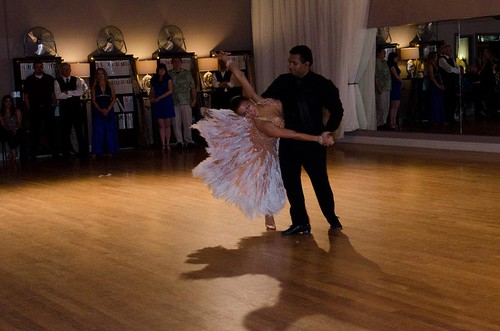Some of the most famous names of Russian descent are associated with ballet, such as Tchaikovsky, Irina Baronova and Mikhail Baryshnikov. But for today’s generation, Karina Smirnoff or Anna Trebunsnkaya often come to mind first, Russian dancers famous for their ballroom dance moves on the popular ABC show Dancing with the Stars. Smirnoff and Trebunsnkaya are both part of a growing trend of Russian dancers taking advantage of their classical ballet training to branch out into ballroom dance.
Today it is Russian immigrants own many of the ballroom dance studios across the United States. At Brighton Beach Ballet Theater, a historic dance studio founded to pass on the Russian tradition of ballet, recently began offering two levels of ballroom dance that have become quite popular amongst students and their parents, 60 percent of which are Russian-speaking families.
“Ballet is still a large part of Russian culture and will never go away,” says Vladimir Lepisko, manager of the Brighton Beach Ballet Theater. “But ballroom dance is just a major trend right now.”
First made popular in the 1930s when Fred Astaire and Ginger Rogers waltzed their way across peoples’ television screens, ballroom dance has revolutionized the art of partner dance. Today, there is a widespread national interest and media frenzy over it, thanks to TV shows like Dancing With the Stars, whose professional cast is comprised largely of Russian dancers.
Competitive ballroom dance, however, was illegal in the former Soviet Union until the 1990s, making its popularity a foreign concept to some of the Theater’s Russian instructors with strict upbringings in ballet.
“In the former Soviet Union, ballet was really the only [professional level] dance available to us,” says BBBT’s Lepisko, who is also a former student of Kiev Ballet Academy. “This kind of dance was only seen when American troupes came to perform for us.”
Some Russian dancers found ways to learn the techniques of ballroom dance by watching the foreign troupes and practicing in secret. According to Renata Shvarts, a former competitive ballroom dancer from Uzbekistan and owner of three ballroom dance studios for Russian children in Manhattan, its liberating qualities are part of what makes ballroom dance so exciting for Russians today.
“Ballroom was an extracurricular, an extension of ballet,” says Shvarts. “But we could not dance professionally, and we were learning techniques on the basis of nothing, with no comparison to Westerners.”
In the 1990s when the curtain lifted on the former USSR and western practices became allowable, Shvarts says that Russian ballroom dancers were ready and willing to do anything to make it as professionals.
“We were ready for ballroom dance on a global scale because we had to do everything just to survive and had no opportunity for growth; now we had it,” she says.
Shvarts came to the United States in the 1990s to make a career in ballroom dance. She competed until the age of 25 when she retired to start a family. Now 33, Shvarts has made it her life’s work to continue teaching ballroom dance to young Russian dancers, breaking them away from the stereotypes and harsh realities of ballet.
“Ballet you can’t use in every day world,” Shvarts says. “It’s a highest form of art and it’s extremely difficult, even prejudiced,” she says, referring to ballet’s notoriously harsh requirements for weight, height and even foot size. “Ballroom dance is universal. You don’t need to be a certain body weight, not all the girls have ballet figures,” she adds. “A little backside on a girl has never hurt anybody’s ballroom career.”
In fact, one element of ballroom dance that has made it so popular is that it’s fun, argues Ilina Rozin, director of Brighton Beach Ballet Theater. Ballroom dance is known for glamorous hair and make-up, over the top costumes, and flashy jeweled accessories. All of this can be appealing to young dancers, and even to their parents, who often times don’t want their children exposed to the harsh criticisms and expectations of the ballet world.
Still, some believe it is Russia’s classic ballet tradition that has made the recent success of Russian ballroom dancers possible. At Brighton Beach Ballet Theater, while Lepisko encourages his students to pursue their individual interests and agrees it is important for dancers in his studio to learn a variety of styles, he still stresses the importance of classical ballet training as a stepping-stone to success in any form of dance.
“Students who have studied ballet have an advantage over other dancers of any style because they have the foundation that their peers don’t,” says Lepisko. “Ballet was a tradition in Russia for that reason; it develops you physically, mentally and culturally. Everyone who wants to move their bodies for a living must study ballet.”
Even Shvarts admits that some basic ballet training can be helpful to develop a ballroom dancer’s posture and flexibility, but thinks that Russians are more successful in all forms of dance solely because of their strict upbringings and intrinsic desires to succeed.
“In the former USSR, everybody had to achieve and be the best; we’re just a disciplined culture,” she says.
And it is that tinge of politics that some say makes this generation’s choice of dance something more. For the Russian community, says Rozin, the transition from ballet to ballroom dance is a way to carry over an age-old tradition while embracing more Western traditions and learning to enjoy the art of dance, which, she argues, is revolutionary.
“While ballet requires you work from your toes to your eyes,” she says, “ballroom dance is freedom.”

